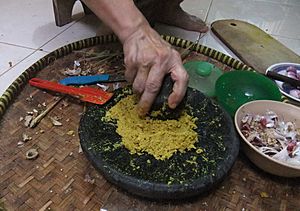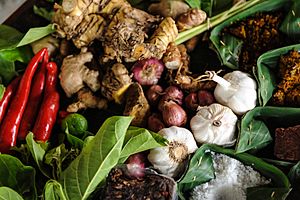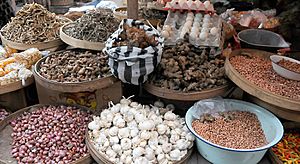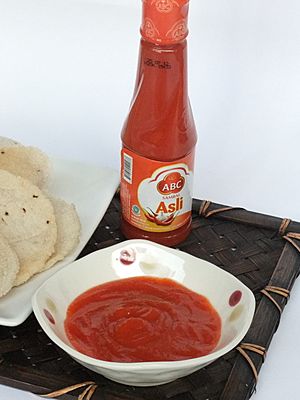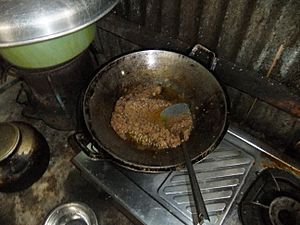Bumbu (seasoning) facts for kids
Bumbu is an Indonesian word for a special mix of spices. It can be a blend of dry spices or a moist paste made from them. Think of it as the secret ingredient that gives Indonesian food its amazing taste! The official Indonesian dictionary says bumbu includes "various types of herbs and plants that have a pleasant smell and flavor — like ginger, turmeric, galangal, nutmeg, and pepper — used to make food taste better."
This spice blend is a key part of Indonesian cuisine and its many regional styles. These include Balinese, Javanese, Sundanese, Padang, Batak, and Manado foods. Bumbu is used in many dishes. You'll find it in stews, soups, barbecue, sotos, gulai, and even in Indonesian-style instant noodles.
Indonesian cooks are experts at using spices like lemongrass, galangal, cardamom, chilies, tamarind, and turmeric. These ingredients create unique and delicious flavors.
Unlike Indian cooking, which often uses dried spice powders, Indonesian cooking is more like Thai food. It prefers fresh ingredients. Traditionally, these fresh spices and other fragrant ingredients are ground into a moist paste. This is usually done using a mortar and pestle.
To make a bumbu paste, spices are often sliced, chopped, ground, or sometimes roasted. People use traditional tools like a stone mortar and pestle, or modern blenders. The bumbu mix is usually stir-fried in hot cooking oil first. This helps release its wonderful smell and flavor. After that, the main ingredients like meats, chicken, or fish are added. In Malaysian cuisine, a similar spice mix is called rempah.
Why Bumbu is Important

The main job of bumbu is to add great flavor and smell to food. But a long time ago, before refrigerators were invented, spices also helped keep food fresh. Some spices like garlic, shallots, ginger, and galangal have properties that fight germs. This means they act as natural ways to preserve food.
Indonesian Spices
Indonesia is famous around the world as the "Spice Islands." The Maluku Islands in Indonesia were key in bringing many native spices to global cooking. Spices like pala (nutmeg/mace), cengkih (clove), daun pandan (Pandan leaves), keluak (Pangium edule), and lengkuas (galangal) originally came from Indonesia.
Other spices were brought to Indonesia from different parts of Asia. Lada hitam (black pepper), kunyit (turmeric), serai (lemongrass), daun kari (curry leaf), bawang merah (shallot), kayu manis (cinnamon), kemiri (candlenut), ketumbar (coriander), jahe (ginger), and asam jawa (tamarind) likely came from India or mainland Southeast Asia. Daun bawang (scallions) and bawang putih (garlic) came from China. These spices arrived a very long time ago and became a big part of Indonesian cooking.
Later, new spices like chili pepper and tomato were brought from the Americas. This happened in the 16th century by Portuguese and Spanish traders during the age of exploration.
Here is a list of common spices used in bumbu:
- Adas manis (anise)
- Andaliman (sichuan pepper)
- Asam jawa (tamarind)
- Bawang bombai (onion)
- Bawang merah (shallot)
- Bawang perei (leek)
- Bawang putih (garlic)
- Bunga lawang (star anise)
- Bunga pala (mace)
- Cabai rawit (bird's eye chillies)
- Cabai merah (red chilli pepper)
- Cengkih (clove)
- Daun bawang (scallion)
- Daun jeruk (lime leaf)
- Daun kari or salam koja (curry leaf)
- Daun kemangi (basil)
- Daun pandan (Pandan leaf)
- Daun salam (Indonesian bay leaf)
- Jahe (ginger)
- Jeruk purut (kaffir lime)
- Jeruk nipis (key lime)
- Jintan (caraway)
- Kepulaga (cardamom)
- Kayu manis (cinnamon)
- Kecombrang (wild ginger)
- Kencur (Kaempferia galanga)
- Kemiri (candlenut)
- Ketumbar (coriander)
- Keluak or kluwek (Pangium edule)
- Kunyit or kunir (turmeric)
- Lengkuas or laos (galangal)
- Lada hitam (black pepper)
- Lada putih (white pepper)
- Lokio (chives)
- Pala (nutmeg)
- Peterseli (parsley)
- Seledri (celery)
- Serai (lemongrass)
- Temu kunci (Chinese keys)
- Temu lawak (curcuma)
Indonesian Seasonings
Indonesian cooking also uses many different sauces and seasonings. Some are basic, some were created in Indonesia, and others were influenced by Indian, Chinese, and European sauces.
Here are some common Indonesian seasonings:
- Garam (salt)
- Gula merah or gula jawa (palm sugar)
- Cuka (vinegar)
- Kecap manis (sweet soy sauce)
- Kecap asin (salty or common soy sauce)
- Kecap ikan (fish sauce)
- Kecap inggris (Worcestershire sauce)
- Minyak kelapa (coconut oil)
- Minyak samin (ghee)
- Minyak wijen (sesame oil)
- Minyak zaitun (olive oil)
- Saus tomat (tomato ketchup)
- Saus cabai or sambal botol (bottled sambal or hot chili sauce)
- Saus tiram (oyster sauce)
- Santan (coconut milk)
- Kacang tanah (peanuts), fried, ground, spiced, and mixed with water to make peanut sauce. You can even find ready-to-use peanut sauces for satay, pecel, or gado-gado in Asian grocery stores.
- Terasi or belacan (shrimp paste)
- Petis (another type of shrimp paste)
- Tauco (fermented soy paste)
- Ang ciu (Chinese cooking red wine)
- Bubuk kaldu (broth powder), like a bouillon cube but in powder form.
- Vetsin (Monosodium glutamate)
Basic Bumbu Types
There are many different bumbu mixes in Indonesian cooking. They change depending on the recipe and the region. For example, Balinese cuisine has a basa genep bumbu, and Minang cuisine has a pemasak bumbu.
However, there are four main types of basic bumbu that are used across Indonesia. They are often named by their color. These basic bumbu mixes are usually made by stir-frying spices in coconut oil. You can use them fresh or store them in the fridge for later.
- Bumbu dasar putih (basic white bumbu) is made from ground shallots, garlic, galangal, candlenut, and coriander. It's used in Indonesian dishes that have a whitish color, like opor ayam (chicken in coconut milk), sayur lodeh (vegetable stew), and many types of soto (soups). Sometimes, Indonesian bay leaf, lemon leaf, and lemongrass are added. It can also be used for rawon (black beef soup), semur (stew), mie goreng (fried noodles), and various stir-fried vegetables, tofu, and tempeh dishes.
- Bumbu dasar merah (basic red bumbu) is made from ground red chili pepper, shallots, garlic, tomato, roasted shrimp paste, coconut sugar, and salt. It's used for Indonesian dishes that have a reddish color. Examples include stir-fried vegetables, nasi goreng (fried rice), and sambal goreng hati (spicy liver dish). People often add daun salam (Indonesian bay leaf), bruised lemongrass, and galangal to it.
- Bumbu dasar kuning (basic yellow bumbu) is made from ground shallots, garlic, sautéed candlenut, roasted turmeric, coriander, ginger, galangal, and black pepper. It gives a yellowish color to dishes like various soto (soups), pepes (steamed food in banana leaves), mie goreng (fried noodles), and ayam goreng (fried chicken). Sometimes, a pickled version called acar is used on top of ikan bakar (grilled fish) or ikan goreng (fried fish).
- Bumbu dasar jingga/oranye (basic orange-colored bumbu) is made from ground red chili pepper, shallots, garlic, caraway, anise, coriander, candlenut, turmeric, ginger, galangal, and black pepper. It's used in Indonesian dishes that have an orange color, such as gulai (curry-like stew), Indonesian curry, kalio, and rendang (a rich meat dish).
See also
 In Spanish: Anexo:Ingredientes de cocina para niños
In Spanish: Anexo:Ingredientes de cocina para niños


